Kherson
Херсон | |
|---|---|
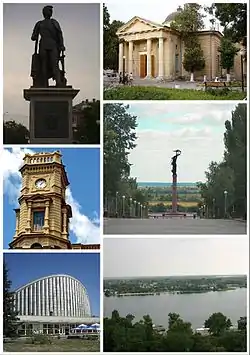 Clockwise from top: St Catherine's cathedral, Memorial in Park Slavy, view of the Dnieper in Kherson, , clock tower of the Kherson Regional Art Museum, monument to Potemkin in Potomkinskyi Garden Square. | |
 Flag  Coat of arms | |
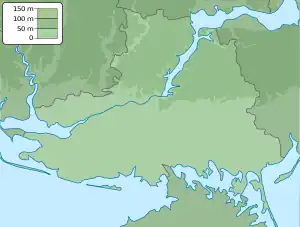 Kherson Location of Kherson 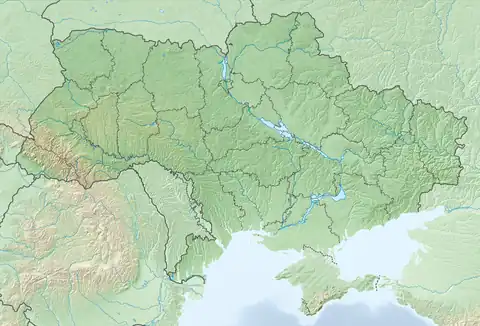 Kherson Kherson (Ukraine) | |
| Coordinates: 46°38′33″N 32°37′30″E / 46.64250°N 32.62500°E | |
| Country | |
| Oblast | Kherson Oblast |
| Raion | Kherson Raion |
| Hromada | Kherson urban hromada |
| Founded | 18 June 1778 |
| Government | |
| • Mayor | Ihor Kolykhaiev[1][lower-alpha 1] |
| • Head of the Kherson City Military Administration[3] | Halyna Luhova[3][lower-alpha 2] |
| Area | |
| • Total | 135.7 km2 (52.4 sq mi) |
| Elevation | 46.6 m (152.9 ft) |
| Population (2022) | |
| • Total | |
| Postal code | 73000 |
| Area code | +380 552 |
| Primary airport | Kherson International Airport |
| Website | miskrada |
Kherson (Ukrainian and Russian: Херсон, Ukrainian: [xerˈsɔn] ⓘ; Russian: [xʲɪrˈson]) is a port city in Ukraine that serves as the administrative centre of Kherson Oblast. Located by the Black Sea and on the Dnieper River, Kherson is the home to a major ship-building industry and is a regional economic centre.[4] At the beginning of 2022, its population was estimated at 279,131.[4]
From March to November 2022, the city was occupied by Russian forces during their invasion of Ukraine. Ukrainian forces recaptured the city on 11 November 2022. In June 2023, the city was flooded following the destruction of the nearby Kakhovka Dam.[5]
Etymology
As the first new settlement in the "Greek project" of Empress Catherine and her favourite Grigory Potemkin, it was named after the Heraclea Pontic colony of Chersonesus, (Greek: Χερσόνησος, translit. Khersónēsos [kʰer.só.nɛː.sos][lower-alpha 3]) which was located on the Crimean Peninsula, meaning 'peninsular shore'.[6][7]
History
Early days and Russian Empire era (until 1917)

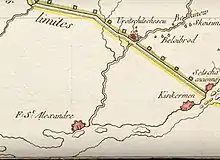
Before 1774, the area where Kherson is situated today belonged to the Crimean Khanate. A German-language map in 1736 (inset) shows a settlement of Bilschowscei at the site of today's Kherson. A French-language map of the site in 1769 (inset) shows a Russian-built fort or sconce named St. Alexandre. This had been built in 1737 during the Russo-Turkish War and served the Zaporizhian Sich as an administrative center, run by local Cossacks.
The Russian Empire annexed the territory in 1774, and a decree of Catherine the Great on 18 June 1778 founded Kherson on the high bank of the Dnieper as a central fortress of the Black Sea Fleet.
1783 saw the city granted the rights of a district town and the opening of a local shipyard where the hulls of the Russian Black Sea fleet were laid. Within a year the Kherson Shipping Company began operations. By the end of the 18th century, the port had established trade with France, Italy, Spain and other European countries. Between 1783–1793 Poland's maritime trade via the Black Sea was conducted through Kherson by the Kompania Handlowa Polska. In 1791, Potemkin was buried in the newly built St. Catherine's Cathedral. In 1803 the city became the capital of the Kherson Governorate.[4]
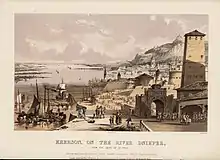
Industry, beginning with breweries, tanneries and other food and agricultural processing, developed from the 1850s. In 1897 the population of the city was 59,076 of which, on the basis of their first language, almost half were recorded as Great Russian, 30% as Jewish, and 20% Ukrainian.[8] During the revolution of 1905 there were workers' strikes and an army mutiny (an armed demonstration by soldiers of the 10th Disciplinary Battalion) in the city.[9]
Soviet era (1917–1991)
Early Bolshevik period
In the Russian Constituent Assembly election held in November 1917—the first and last free election in Kherson for 70 years—Bolsheviks who had seized power in Petrograd and Moscow received just 13.2 percent of the vote in the Governorate. The largest electoral bloc in the district, with 43 percent of the vote, was an alliance of Ukrainian Socialist Revolutionaries (SRs), Russian Socialist Revolutionaries and the United Jewish Socialist Workers Party.[10]
The Bolsheviks dissolved SR-dominated Assembly after its first sitting,[11] and proceeded to force from Kiev the Central Council of Ukraine (Tsentralna Rada) whose response to the Leninist coup had been to proclaim the independence of the Ukrainian People's Republic (UPR). But, before the Bolsheviks could secure Kherson, they were obliged to cede the region under the terms of the March 1918 Treaty of Brest-Litovsk to the German and Austrian controlled Ukrainian State. After the withdrawal of German and Austrian forces in November 1918, the efforts of the UPR (the Petluirites) to assert authority were frustrated by a French-led Allied intervention which occupied Kherson in January 1919.[12]
.jpg.webp)
In March 1919, the Green Army of local warlord Otaman Nykyfor Hryhoriv ousted the French and Greek garrison and precipitated the Allied evacuation from Odesa. In July, the Bolsheviks defeated Hryhoriv who had called upon the Ukrainian people to rise against the "Communist impostors" and their "Jewish commissars,"[13] and had perpetrated pogroms,[13] including in the Kherson region.[14] Kherson itself was occupied by the counter-revolutionary Whites before finally falling to the Bolshevik Red Army in February 1920.[4] In 1922 the city and region was formally incorporated into the Ukrainian SSR a constituent republic of the Soviet Union.
The population was radically reduced from 75,000 to 41,000 by the famine of 1921–3, but then rose steadily, reaching 97,200 in 1939.[15] In 1940, the city was one of the sites of executions of Polish officers and intelligentsia committed by the Soviets as part of the Katyn massacre.[16]
World War II and post-War period
Further devastation and population loss resulted from the German occupation during the Second World War. The German occupation, which lasted from August 1941 to March 1944, contended with both Soviet and Ukrainian nationalist (OUN) underground cells. The Kherson district leadership of the OUN was headed by Bohdan Bandera (brother of OUN leader Stepan Bandera).[17] The Germans operated a Nazi prison and the Stalag 370 prisoner-of-war camp in the city.[18][19]
In the post-war decades, which saw substantial industrial growth, the population more than doubled, reaching 261,000 by 1970.[20] The new factories, including the Comintern Shipbuilding and Repairs Complex, the Kuibyshev Ship Repair Complex, and the Kherson Cotton Textile Manufacturing Complex (one of the largest textile plants in the Soviet Union), and Kherson's growing grain-exporting port, drew in labour from the Ukrainian countryside. This changed the city's ethnic composition, increasing the Ukrainian share from 36% in 1926 to 63% in 1959, while reducing the Russian share from 36 to 29%. The Jewish population never recovered from the Holocaust visited by the Germans: accounting for 26% of residents in 1926, their number had fallen to just 6% in 1959.[20]
In independent Ukraine
With a turnout of 83.4% of eligible voters, 90.1% of the votes cast in Kherson Oblast affirmed Ukrainian independence in the national referendum of 1 December 1991.[21] With the collapse of the Soviet Union, Kherson and its industries experienced severe dislocation. Over the following three decades, the population of both the city and the region declined, reflecting both a significant excess of deaths over live births and persistent net-emigration from the area.[22][23]
The 2014 pro-Russian unrest in eastern and southern Ukraine was marked in Kherson by a small demonstration of some 400 persons.[24] Following Russian occupation of Crimea in 2014, Kherson housed the office of the Ukrainian President's representative in Crimea.[25]
In July 2020, as part of the general administrative reform of Ukraine, the Kherson Municipality was merged as Kherson urban hromada into newly established Kherson Raion, one of five raions in the Kherson Oblast of which the city remained the administrative centre.[26][27]
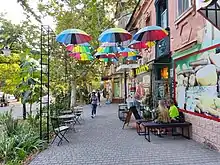
A "City Profile", part of the SCORE (Social Cohesion and Reconciliation)[28] Ukraine 2021 project funded by USAID, the United Nations Development Programme (UNDP), and the European Union, concluded that "more than 80% of citizens in Kherson city feel their locality is a good place to live, work, and raise a family". This was despite a low level of trust in the local authorities in whom corruption was perceived to be high. It also found that, while more inclined to express support for co-operation with Russia than for membership of the EU, "citizens in Kherson feel attached to their Ukrainian identity".[29]
2020 local election
In the last free elections before the 2022 Russian invasion, the Ukrainian local elections held on 25 October 2020, the results of Kherson City Council elections were as follows:[30]
| Party | Percentage of vote | Seats |
|---|---|---|
| We have to live here! | 23.10% | 17 seats |
| Opposition Platform — For Life | 14.51% | 11 seats |
| Servant of the People | 13.01% | 10 seats |
| Volodymyr Saldo Bloc | 11.76% | 9 seats |
| European Solidarity | 8.59% |
The parties widely perceived as pro-Russian, and Euro-skeptic,[31] Opposition Platform, Volodymyr Saldo Bloc, and Party of Shariy (3.89%) had a combined vote of just over 30% of the total, and secured 20 out of the 54 seats on the city council. In the wake of the invasion, the Opposition Platform and the Party of Shariy were banned by the National Security Council for alleged ties to the Kremlin.[32][33][34]
The Volodymyr Saldo Bloc dissolved; its deputies in Kyiv joined the newly formed faction "Support to the programs of the President of Ukraine".[35] From 26 April 2022, Volodymyr Saldo himself, who had been mayor of Kherson from 2002 to 2012, went on to serve the Russian occupiers, as head of the Kherson military–civilian administration.[36][37]
Russian invasion of Ukraine

Kherson witnessed heavy fighting in the first days of the 2022 Russian invasion of Ukraine (Kherson offensive).[38] As of 2 March the city was under Russian control,[39][40] and as early as 8 March the Russian FSB was reported to be tasked with crushing resistance.[41]
Under the Russian occupation, locals continued to stage street protests against the invading army's presence and in support of the unity of Ukraine.[42][43] According to the Ukrainian government, the Russian military sought to create a puppet Kherson People's Republic in the style of the Russian-backed separatist polities in the Donbas region and tried to coerce local councillors into endorsing the move, detaining those activists and officials who opposed their design.[44]
By 26 April 2022, Russian troops had taken over the city's administration headquarters and had appointed both a new mayor,[45] former KGB agent Alexander Kobets, and ex-mayor Volodymyr Saldo as a new civilian-military regional administrator.[46] The next day, Ukraine's Prosecutor General said that troops used tear gas and stun grenades to disperse a further pro-Ukraine rally in the city centre.[45] In an indication of an intended split from Ukraine, on the 28th the new administration announced that from May it would switch the region's payments to the Russian ruble. Citing unnamed reports about alleged discrimination of Russian speakers, its deputy head, Kirill Stremousov said that "reintegrating the Kherson region back into a Nazi Ukraine is out of the question".[47]
On 30 May the Russian-backed occupation authority in Kherson claimed that it had started exporting last year's grain from Kherson to Russia. They would also be working on exporting sunflower seeds.[48]
On 6 June it was reported by the Ukrainian mayor of Kherson, Ihor Kolykhaiev, that the occupiers had conducted a meeting of more than 70 Russian sympathizers aimed at conducting a referendum on the region integrating the occupied areas into Russia. His sources told him that the dates discussed were two: in September or at the end of 2022.[49] As a Russian election was going to take place on 11 September, the Kherson vote would be scheduled to coincide with that day.[50] An elected official in Russia named Igor Kastyukevich had discussed this plan on 7 June, following the visit to Kherson of Sergei Kiriyenko, the deputy chief of staff of the Russian presidential administration.[49][51]
.jpg.webp)
.jpg.webp)
.jpg.webp)
By June, the occupiers were switching Ukrainian schools to their educational curriculum and Russian SIM cards were on the market. Kolykhaiev witnessed the occupiers distributing Russian passports. A cafe frequented by the occupiers was bombed on 7 June and at least four people were injured.[49] Stremousov said on 29 June that "The Kherson region will decide to join the Russian Federation and become a full-fledged subject as one unified state."[50] On the same visit, Kiriyenko spoke at the United Russia party's humanitarian aid center in Kherson: "The Kherson region's admission into Russia will be complete, similar to Crimea," recalling the 2014 Crimean status referendum.[52]
On 18 June it was announced that Russian FSB officers were in the process of moving from hotels to apartments that had been vacated by Ukrainians.[53]
In late June the first Russian bank opened in Kherson,[54] while Oleksii Kovalov, an ex-member of the Ukrainian Servant of the People party, survived an assassination attempt after he had been appointed vice-president.[55]
On 24 June Dmytro Savluchenko, who led the Directorate for Family, Youth, and Sports of the Russian occupation administration, was assassinated by the explosion of a car bomb.[56]
On 29 June the Ukrainian mayor of Kherson, Kolykhaiev, was detained by Russian security forces.[57]
On 5 July, Volodymyr Saldo announced that the former deputy head of government in the Russian exclave of Kaliningrad Sergei Yeliseyev, a graduate of the FSB Academy, was to assume the presidency of the oblast.[54][55]
On 28 August 2022 the vice-president of the occupation administration (Kovalev) was found shot dead inside his own apartment in Zaliznyi Port.[58] His wife was stabbed in the same attack and she died later in the hospital.[59]
On 30 September 2022, the Russian Federation claimed to have annexed Kherson Oblast.[60] The United Nations General Assembly condemned the proclaimed annexations with a vote of 143–5.[61]
Russian forces were ordered to withdraw from the city by defence minister Sergei Shoigu and regroup on the eastern side of the Dnieper on 9 November 2022. Ukrainian officials claimed that Russian troops were destroying bridges connecting the city to the other bank of the river.[62][63] On 11 November, Ukraine announced that its forces had entered the city following the Russian withdrawal.[64][65]
Before retreating, the Russian army destroyed infrastructure facilities of the city (communications, water, heat, electricity, TV tower),[66][67] looted two main museums (Local History Museum and the Art Museum), transporting their items to Crimean museums,[68][69] and took away several monuments to historical figures.[70][71]
On 5 June 2023, Ukraine ordered evacuations after the nearby Kakhovka Dam was destroyed.[72]
On 23 October 2023, online voting concluded on the renamings of numerous streets and localities in Kherson for purposes of decolonization and derussification. Numerous localities named for Russian historical figures - many of whom were perceived to be associated with Russian imperialism - were renamed after Ukrainian and international historical figures who had helped Ukraine and its people. This was in accordance with Law of Ukraine "On Condemnation and Prohibition of Propaganda of Russian Imperial Policy in Ukraine and Decolonization of Toponymy", giving local councils six months to remove problematic toponymy.[73]
Demographics
|
| ||||||||||||||||||||||||||||||||||||||||||
| Source: [15] | |||||||||||||||||||||||||||||||||||||||||||
Ethnicity
According to the Ukrainian National Census in 2001, Kherson had a majority population of Ukrainians (76.6%), with a large minority of Russians (20.0%) and 3.4% others.
Languages
| Languages | 1897[74] | 2001[75] |
|---|---|---|
| Ukrainian | 19.6% | 73.2% |
| Russian | 47.2% | 24.9% |
| Yiddish | 29.1% | |
| Polish | 1.7% | |
| German | 0.7% |
Administrative divisions
There are three city raions:
- Tsentralnyi Raion, also known as the Central Raion, [76] is the central and oldest district of the city. Includes departments: Tavriiskyi, Pіvnichnyi and Mlyny. It was known as Suvorivskyi Raion until October 2023, when it was renamed in compliance with nationwide laws on derussification of toponymy.[76] The old name was derived from that of the Tsarist Russian military leader Alexander Suvorov.
- Dniprovskyi Raion, named for the Dnieper river. Includes departments: Antonivka, Molodizhne, Zelenivka, Petrivka, Bohdanivka, Soniachne, Naddniprianske, Inzhenerne.
- Korabelnyi Raion, which includes the following departments: Shumenskyi, Korabel, Zabalka, Sukharne, Zhytloselyshche, Selyshche-4, Selyshche-5.
Geography
Climate
Under the Köppen climate classification, Kherson has a humid continental climate (Dfa).[77]
| Climate data for Kherson (1991–2020, extremes 1955–present) | |||||||||||||
|---|---|---|---|---|---|---|---|---|---|---|---|---|---|
| Month | Jan | Feb | Mar | Apr | May | Jun | Jul | Aug | Sep | Oct | Nov | Dec | Year |
| Record high °C (°F) | 15.2 (59.4) |
18.6 (65.5) |
22.7 (72.9) |
32.0 (89.6) |
37.7 (99.9) |
39.5 (103.1) |
40.5 (104.9) |
40.7 (105.3) |
36.4 (97.5) |
32.0 (89.6) |
21.8 (71.2) |
17.2 (63.0) |
40.7 (105.3) |
| Mean daily maximum °C (°F) | 1.4 (34.5) |
3.1 (37.6) |
8.8 (47.8) |
16.5 (61.7) |
22.9 (73.2) |
27.5 (81.5) |
30.3 (86.5) |
30.1 (86.2) |
23.7 (74.7) |
16.1 (61.0) |
8.4 (47.1) |
3.3 (37.9) |
16.0 (60.8) |
| Daily mean °C (°F) | −1.6 (29.1) |
−0.6 (30.9) |
4.1 (39.4) |
10.6 (51.1) |
16.7 (62.1) |
21.2 (70.2) |
23.8 (74.8) |
23.3 (73.9) |
17.5 (63.5) |
10.9 (51.6) |
4.7 (40.5) |
0.4 (32.7) |
10.9 (51.6) |
| Mean daily minimum °C (°F) | −4.4 (24.1) |
−3.8 (25.2) |
0.0 (32.0) |
5.0 (41.0) |
10.6 (51.1) |
15.3 (59.5) |
17.5 (63.5) |
16.7 (62.1) |
11.8 (53.2) |
6.3 (43.3) |
1.6 (34.9) |
−2.2 (28.0) |
6.2 (43.2) |
| Record low °C (°F) | −26.3 (−15.3) |
−24.4 (−11.9) |
−20.2 (−4.4) |
−7.9 (17.8) |
−1.5 (29.3) |
5.5 (41.9) |
9.2 (48.6) |
6.6 (43.9) |
−5.0 (23.0) |
−7.6 (18.3) |
−16.2 (2.8) |
−22.2 (−8.0) |
−26.3 (−15.3) |
| Average precipitation mm (inches) | 33 (1.3) |
28 (1.1) |
30 (1.2) |
32 (1.3) |
43 (1.7) |
59 (2.3) |
44 (1.7) |
29 (1.1) |
38 (1.5) |
36 (1.4) |
34 (1.3) |
38 (1.5) |
444 (17.5) |
| Average extreme snow depth cm (inches) | 2 (0.8) |
3 (1.2) |
1 (0.4) |
0 (0) |
0 (0) |
0 (0) |
0 (0) |
0 (0) |
0 (0) |
0 (0) |
0 (0) |
1 (0.4) |
3 (1.2) |
| Average rainy days | 9 | 7 | 9 | 12 | 11 | 11 | 9 | 6 | 9 | 9 | 12 | 10 | 114 |
| Average snowy days | 11 | 10 | 6 | 0 | 0 | 0 | 0 | 0 | 0 | 0.3 | 4 | 8 | 39 |
| Average relative humidity (%) | 85.5 | 82.1 | 77.1 | 68.5 | 64.8 | 65.3 | 62.1 | 60.7 | 68.4 | 76.4 | 84.9 | 86.8 | 73.6 |
| Mean monthly sunshine hours | 66 | 89 | 142 | 215 | 275 | 301 | 333 | 307 | 233 | 152 | 76 | 49 | 2,238 |
| Source 1: Pogoda.ru.net[78] | |||||||||||||
| Source 2: World Meteorological Organization (humidity 1981–2010, sun 1991-2020)[79] [80] | |||||||||||||
Transport
Ports
Kherson has both a seaport, Port of Kherson and a river port, Kherson River Port.
Rail
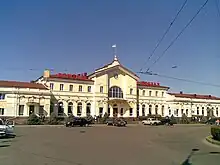
Kherson is connected to the national railroad network of Ukraine. There are daily long-distance services to Kyiv, Lviv and other cities.
Air
Kherson is served by Kherson International Airport.[81] It operates a 2,500 x 42-meter concrete runway, accommodating Boeing 737, Airbus 319/320 aircraft, and helicopters of all series.[82]
Education

There are 77 high schools as well as 5 colleges. There are 15 institutions of higher education, including:
- Kherson State Maritime Academy
- Kherson State Agrarian and Economic University
- Kherson State University
- Kherson National Technical University
- International University of Business and Law
The documentary Dixie Land was filmed at a music school in Kherson.[83]
Main sights
- The Church of St. Catherine – was built in the 1780s, supposedly to Ivan Starov's designs, and contains the tomb of Prince Grigory Potemkin.
- Jewish cemetery – Kherson has a large Jewish community which was established in the mid-nineteenth century.[84]
- Kherson TV Tower
- Adziogol Lighthouse, a hyperboloid structure designed by Vladimir Shukhov in 1911
- The Kherson Art Museum[85] has a collection of icons, and Ukrainian and Russian paintings and sculptures. Particularly noteworthy are Portrait of a Woman (1883) by Konstantin Makovsky; The Tempest is Coming by Ivan Aivazovsky; Sunset by Alexei Savrasov; Cattle Yard in Abramtsevo by Vasily Polenov; At the Stone by Ivan Kramskoi; The Charioteer, by Peter Clodt von Jürgensburg (sculptor); Prince Svyatoslav by Eugene Lanceray (sculptor); Mephistopheles by Mark Antokolsky (sculptor); Near the Monastery by German painter August von Bayer (1859); Oaks (1956); Moloditsya (1938) and Still Life with the Blue Broom (1930), by Oleksii Shovkunenko (born in Kherson).
Notable people
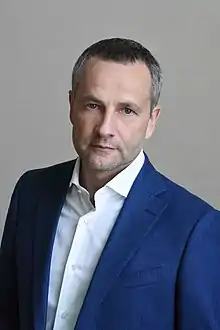
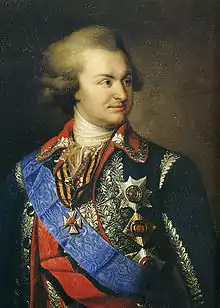
- Grigory Adamov (1886–1945), Soviet science fiction writer
- Georgy Arbatov (1923–2010), Soviet and Russian political scientist.[86]
- Vladimir Baranov-Rossine (1888–1944), Ukrainian/Russian/French painter, avant-garde artist and inventor.
- Max Barskih (born 1990), Ukrainian singer and songwriter.
- Stefania Berlinerblau (1852–1921), American anatomist and physician, investigated blood circulation
- Maximilian Bern (1849–1923), German writer and editor.
- Sergei Bondarchuk (1920–1994), Soviet and Russian actor, film director, and screenwriter
- Lev Davidovitch Bronstein (1879–1940), better known as Leon Trotsky, Bolshevik revolutionary and Marxist theorist, was born in the village of Bereslavka, Kherson Governorate.[87]
- Artem Datsyshyn (1979–2022), Ukrainian ballet dancer and soloist
- Ivan Gannibal (1735–1801), eminent Russian military leader and a founder of the city
- Sergei Garmash (born 1958), Soviet and Russian film and stage actor.
- Yefim Golïshev (1897–1970), painter and composer associated with the Dada movement in Berlin.
- Nikolai Grinko (1920–1989), Soviet and Ukrainian actor
- Kateryna Handziuk (1985–2018), Ukrainian civil rights and anti-corruption activist
- John Howard (1726–1790), English prison reformer; he died of typhus whilst in Kherson.[88]
- Mircea Ionescu-Quintus (1917–2017), Romanian politician, writer and jurist
- Yurii Kerpatenko (1976–2022), Ukrainian conductor
- Ihor Kolykhaiev (born 1971), Ukrainian politician and entrepreneur, Mayor of Kherson since 2020
- Samuel Maykapar (1867–1938), Russian romantic composer, pianist and professor of music
- Yuriy Odarchenko (born 1960),a politician, Governor of Kherson Oblast since 2014
- Nicholas Perry (born 1992), social media personality, known online as Nikocado Avocado
- Sergei Polunin (born 1989), Russian ballet dancer, actor and model.[89]
- Prince Grigory Potemkin (1739–1791), military leader, statesman and nobleman; a founder of the city.[90]
- Salomon Rosenblum (1873–1925), later known as Sidney Reilly, a secret agent, adventurer and playboy, employed by the British Secret Intelligence Service; may have inspired spy character, James Bond.
- Nissan Rilov (1922–2007), former soldier, Israeli artist and supporter of Palestinians
- Moshe Sharett (1894–1965), 2nd Prime Minister of Israel from 1953 to 1955
- Viktor Petrovich Skarzhinsky (1787–1861), wealthy landowner; squadron commander in the Russian Patriotic War of 1812[91]
- Inna Shevchenko (born 1990), Ukrainian feminist and leader of the women's movement FEMEN
- Sergei Stanishev (born 1966), Bulgarian politician, 49th Prime Minister of Bulgaria
- Prince Alexander Suvorov (1730–1800), Russian general; a founder of the city.[92]
- Svitlana Tarabarova (born 1990), Ukrainian singer, songwriter, music producer and actress.
- Mikhail Yemtsev (1930–2003), Soviet and Russian science fiction writer
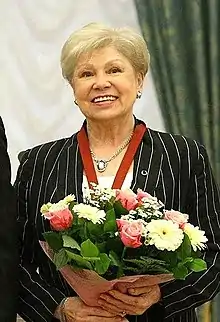
Sport
- Anastasiia Chetverikova (born 1998), sprint canoeist, team silver medallist at the 2020 Summer Olympics
- Inna Gaponenko (born 1976), chess player, International Master & Woman Grandmaster.
- Oleksandr Holovko (born 1972), former footballer with 414 club caps and 58 for Ukraine
- Pavlo Ishchenko (born 1992), Ukrainian-Israeli boxer
- Oleksandr Karavayev (born 1992), footballer with over 250 club caps and 45 for Ukraine
- Yevhen Kucherevskyi (1941–2006), Ukrainian football coach of Dnipro Dnipropetrovsk
- Larisa Latynina (born 1934), Soviet gymnast, has won nine Olympic gold medals
- Tatiana Lysenko (born 1975), Soviet and Ukrainian gymnast, two gold and a bronze medal at the 1992 Summer Olympics
- Yuriy Maksymov (born 1968), football coach and former midfielder with 384 club caps and 27 for Ukraine.
- Yuri Nikitin (born 1978), gymnast and gold medallist at the 2004 Summer Olympics
- Sergei Postrekhin (born 1957), sprint canoer, gold and silver medallist at the 1980 Summer Olympics
- Serhiy Tretyak (born 1963), retired Ukrainian footballer with over 500 club caps
- David Tyshler (1927–2014), Ukrainian/Soviet fencer, two gold and a bronze medal at the 1956 Summer Olympics
- Roman Vintov (born 1978), former Russian/Ukrainian footballer with over 460 club caps
Twin cities
Notes
- ↑ Kolykhaiev's whereabouts are unknown as of 19 August 2022, on 28 June 2022 he was abducted by Russian forces during the occupation of Kherson[2]
- ↑ Luhova was appointed by Ukrainian President Volodymyr Zelenskyy on 21 September 2022 and performs the functions of Mayor[3]
- ↑ From two Greek words: khersos (χέρσος, "dry") and nesos (νῆσος, "land")
References
- ↑ (in Ukrainian) The mayor of Kherson became the people's deputy majoritarian Archived 22 November 2020 at the Wayback Machine, Ukrainska Pravda (16 November 2020)
- ↑ "FSB errors played crucial role in Russia's failed war plans in Ukraine". Washington Post. 19 August 2022. Retrieved 31 August 2022.
- 1 2 3 Alona Zakharov (21 September 2022). "Was Kolyhaev's secretary: Zelensky appointed a head of the Herson military administration". 24 Kanal (in Ukrainian). Retrieved 25 December 2022.
- 1 2 3 4 "Херсон", Большая Советская Энциклопедия, том 46 (The Great Soviet Encyclopedia, Vol. 46), Б. А. Введенский 2-е изд.(B. A. Vvedensky ed.. 2nd Edition). . М., Государственное научное издательство «Большая Советская энциклопедия» (State Scientific Publishing House), 1957, pp. 121–122
- ↑ Sabbagh, Dan (6 June 2023). "As flood waters rise around them, Kherson residents cast blame for destroyed dam on 'inhumane' Moscow". The Guardian. ISSN 0261-3077. Retrieved 6 June 2023.
- ↑ Yanko, M.T. [Янко М.Т.] (1998). Toponimichnyi slovnyk Ukrainy: slobnyk-doidnyk Топонімічний словник України: словник-довідник [Toponymic dictionary of Ukraine: Reference Dictionary].
- ↑ Luchyk, V.V. [Лучик В.В.] (2014). Etymolohichnyi slovnyk toponimiv Ukrainy Етимологічний словник топонімів України [Etymological dictionary of Toponyms of Ukraine].
- ↑ "Демоскоп Weekly – Приложение. Справочник статистических показателей". Demoscope.ru. Archived from the original on 11 June 2022. Retrieved 19 July 2022.
- ↑ Херсон // Советская историческая энциклопедия / редколл., гл. ред. Е. М. Жуков. том 15. М., государственное научное издательство «Советская энциклопедия», 1974. ("Kherson", Soviet Historical Encyclopedia. Vol. 15, E. M. Zhukov. ed., State Scientific Publishing House), 1974. pp 504–506, 571–573
- ↑ Oliver Henry Radkey (1989). Russia goes to the polls: the election to the all-Russian Constituent Assembly, 1917. Cornell University Press. pp. 161–163. ISBN 978-0-8014-2360-4.
- ↑ Orlando Figes, A People's Tragedy: The Russian Revolution 1891–1924, London: Pimlico (1997), p. 516.
- ↑ Akulov, Mikhail (18 October 2013). "War Without Fronts: Atamans and Commissars in Ukraine, 1917–1919". Archived from the original on 3 April 2019. Retrieved 10 August 2022 – via Digital Access to Scholarship at Harvard.
- 1 2 Werth, Nicolas (2019). "Chap. 5: 1918-1921. Les pogroms des guerres civiles russes". Le cimetière de l'espérance. Essais sur l'histoire de l'Union soviétique (1914–1991) [Cemetery of Hope. Essays on the History of the Soviet Union (1914–1991)]. Collection Tempus (in French). Perrin. ISBN 978-2-262-07879-9.
- ↑ Danilenko, Vladimir (2006). Jewish Pogroms in Ukraine, 1918–1921. Fond FR-3050 Kiev District Commission of the Jewish Public Committee for the Provision of Aid to Victims of Pogroms; Opis' 1–3 (PDF). Kyiv: The State Archive of the Kyiv Oblast. p. 4. Archived (PDF) from the original on 28 September 2021. Retrieved 6 April 2022.
- 1 2 "Kherson". www.encyclopediaofukraine.com. Retrieved 1 November 2023.
- ↑ Zbrodnia katyńska (in Polish). Warszawa: IPN. 2020. p. 17. ISBN 978-83-8098-825-5.
- ↑ Владимир Ковальчук. Богдан — загадочный брат Степана Бандеры Газета «День», № 30, 20 февраля 2009 года. // day.kyiv.ua ("Vladimir Kovalchuk. Bogdan is Stepan Bandera's mysterious brother", The Day, No. 30, 20 February 2009. // day.kyiv.ua)
- ↑ "Gefängnis Cherson". Bundesarchiv.de (in German). Archived from the original on 7 May 2022. Retrieved 7 May 2022.
- ↑ "German Camps". Retrieved 7 May 2022.
- 1 2 "Kherson". Encyclopediaofukraine.com. Archived from the original on 11 March 2022. Retrieved 6 April 2022.
- ↑ "Ukrainian Independence Referendum". Seventeen Moments in Soviet History. 28 September 2015. Archived from the original on 14 April 2022. Retrieved 6 April 2022.
- ↑ "На Херсонщині демографічна ситуація загострюється: на 100 померлих – 38 новонароджених". Херсонщина за день – новости Херсона и Херсонской области, Kherson News (in Russian). Archived from the original on 31 August 2022. Retrieved 31 August 2022.
- ↑ "На Херсонщині зменшується чисельність населення". khersonci.com.ua. Archived from the original on 30 September 2022. Retrieved 31 August 2022.
- ↑ "В Херсоне прошел пророссийский митинг". Liga.net. 1 March 2014. Archived from the original on 10 August 2022. Retrieved 10 August 2022.
- ↑ Official website Archived 3 March 2016 at the Wayback Machine. Presidential representative of Ukraine in Crimea.
- ↑ "Про утворення та ліквідацію районів. Постанова Верховної Ради України № 807-ІХ". Голос України (in Ukrainian). 18 July 2020. Archived from the original on 9 July 2021. Retrieved 3 October 2020.
- ↑ "Нові райони: карти + склад" (in Ukrainian). Міністерство розвитку громад та територій України. 17 July 2020. Archived from the original on 2 March 2021. Retrieved 26 September 2021.
- ↑ Newton, Andrew. "SCORE Index". www.scoreforpeace.org. Archived from the original on 1 September 2022. Retrieved 10 August 2022.
- ↑ SCORE Eastern Ukraine 2021 (23 June 2022). "Ukraine: Kherson 2021, City Profile – Ukraine | ReliefWeb". reliefweb.int. Archived from the original on 30 September 2022. Retrieved 10 August 2022.
{{cite web}}: CS1 maint: numeric names: authors list (link) - ↑ "Kherson. City Council elections 25 October 2020. Results, Ukraine Elections". ukraine-elections.com.ua. Archived from the original on 25 May 2022. Retrieved 26 June 2022.
- ↑ "Kennan Cable No. 45: Six Reasons the "Opposition Platform" Won in Eastern Ukraine | Wilson Center". www.wilsoncenter.org. Archived from the original on 28 March 2022. Retrieved 19 August 2021."The changing face of pro-Russian political forces in Ukraine". Uacrisis.org. 9 July 2021. Archived from the original on 28 March 2022. Retrieved 19 August 2021.
- ↑ "Parliament dissolves pro-Russian Opposition Platform faction following Security Council ban". 14 April 2022. Archived from the original on 25 June 2022. Retrieved 26 June 2022.
- ↑ "NSDC bans pro-Russian parties in Ukraine". Ukrinform. 20 March 2022. Archived from the original on 20 March 2022. Retrieved 20 March 2022.
- ↑ (in Ukrainian) Court bans Sharia Party Archived 26 June 2022 at the Wayback Machine, Ukrainska Pravda (16 June 2022)
- ↑ "Депутати "Блоку Сальдо" не згодні з діями Сальдо: написали лист керівництву Херсонської облради". Suspilne.media. Archived from the original on 20 March 2022. Retrieved 20 March 2022.
- ↑ "Kherson mayor refuses to cooperate with collaborators and invaders". Ukrinform. 26 April 2022. Archived from the original on 8 June 2022. Retrieved 27 April 2022.
- ↑ "Российские оккупационные силы назначили своих "руководителей" в Херсоне и области" [Russian occupation forces appoint their "leaders" in Kherson and oblasts]. Crimea.Realities (in Russian). 26 April 2022. Archived from the original on 9 May 2022. Retrieved 27 April 2022.
- ↑ "Fighting under way near Kherson, Mykolaiv, Odessa – Ukrainian official". Reuters. 26 February 2022. Archived from the original on 26 February 2022. Retrieved 26 February 2022.
- ↑ Oliphant, Roland (2 March 2022). "Vladimir Putin set to 'cut Ukraine in two' as key city of Kherson falls to Russians". The Daily Telegraph. Archived from the original on 3 March 2022. Retrieved 3 March 2022.
- ↑ "Kherson falls — Kyiv under fire — Mariupol tragedy". Politico.eu. 3 March 2022. Archived from the original on 3 March 2022. Retrieved 3 March 2022.
- ↑ "Ukraine's military: As Russian invasion slows down, FSB goes after resistance in Kherson and Mykolaiv regions". The Kyiv Independent. 8 March 2022. Archived from the original on 6 July 2022. Retrieved 6 July 2022.
- ↑ "Crowds take to the streets of Kherson". BBC News. 13 March 2022. Archived from the original on 13 March 2022. Retrieved 13 March 2022.
- ↑ Peterson, Scott; Naselenko, Oleksandr (6 April 2022). "Tear gas, arrogance, and resistance: Life in Russia-occupied Kherson". Christian Science Monitor. ISSN 0882-7729. Archived from the original on 20 June 2022. Retrieved 7 April 2022.
- ↑ "Missing reporter among several journalists, activists and officials said to be detained by Russian forces". CNN. 19 March 2022. Archived from the original on 19 March 2022. Retrieved 19 March 2022.
- 1 2 Prentice, Alessandra; Zinets, Natalia (27 April 2022). "Russian forces disperse pro-Ukraine rally, tighten control in occupied Kherson". Reuters. Archived from the original on 8 May 2022. Retrieved 27 April 2022.
- ↑ "Russian-Occupied Kherson Names New Leadership Amid Pro-Ukraine Protests, Rocket Attacks". The Moscow Times. 28 April 2022. Archived from the original on 7 May 2022. Retrieved 28 April 2022.
- ↑ Vasilyeva, Nataliya (28 April 2022). "Occupied Kherson will switch to Russian currency, puppet government says". The Telegraph. ISSN 0307-1235. Archived from the original on 7 May 2022. Retrieved 28 April 2022.
- ↑ Vasilyeva, Nataliya (30 May 2022). "Russian-controlled Kherson region in Ukraine starts grain exports to Russia – TASS". Reuters. Archived from the original on 31 May 2022. Retrieved 30 May 2022.
- 1 2 3 Aleksandrov, Aleksei (11 June 2022). "Russia Moving Forward With 'Referendum' Plans in Occupied Southern Ukraine, Says Kherson Mayor". Radio Free Europe/Radio Liberty. Archived from the original on 10 July 2022. Retrieved 8 July 2022.
- 1 2 "Occupied Kherson Readying for Vote to Join Russia, Official Claims". The Moscow Times. 29 June 2022. Archived from the original on 8 July 2022. Retrieved 8 July 2022.
- ↑ "Kherson region to prepare for referendum on joining Russia – Head of Oblast Military Administration". LIMITED LIABILITY COMPANY "UP MEDIA PLUS". Ukrainska Pravda. 7 June 2022. Archived from the original on 8 July 2022. Retrieved 8 July 2022.
- ↑ Abbasova, Vusala (10 June 2022). "Kremlin Reveals Plans to Hold Referendum on Joining Russia in Kherson". Caspian News. Archived from the original on 8 July 2022. Retrieved 8 July 2022.
- ↑ "In Kherson, the occupiers plan to settle Russian FSB officers in the apartments of Ukrainians". The Odessa Journal. 18 June 2022. Archived from the original on 6 July 2022. Retrieved 6 July 2022.
- 1 2 "FSB Official Takes Over Moscow-Occupied Kherson Region". The Moscow Times. AFP. 5 July 2022. Archived from the original on 6 July 2022. Retrieved 6 July 2022.
- 1 2 "Ukraine : un ancien du FSB à la tête du gouvernement de la région occupée de Kherson". Le Figaro. AFP. 5 July 2022. Archived from the original on 6 July 2022. Retrieved 6 July 2022.
- ↑ "Moscow-Imposed Official In Russian-Occupied Ukrainian City Killed By Car Bomb". Radio Free Europe/Radio Liberty. 24 June 2022. Archived from the original on 14 July 2022. Retrieved 17 July 2022.
- ↑ "Russia security forces detain mayor of Ukrainian city of Kherson -officials". Reuters. 29 June 2022. Archived from the original on 9 July 2022. Retrieved 6 July 2022.
- ↑ "Top Pro-Russian Official Shot Dead in Ukraine's Kherson". The Moscow Times. AFP. 30 August 2022. Archived from the original on 30 August 2022. Retrieved 30 August 2022.
- ↑ "Another Russia-Imposed Official Attacked In Occupied Area Of Ukraine". Radio Free Europe/Radio Liberty. 6 September 2022.
- ↑ "Russia-Ukraine war live: Putin annexes Ukrainian regions; Kyiv applies for Nato membership". TheGuardian.com. 30 September 2022.
- ↑ "UN General Assembly Condemns Russia's 'Illegal Annexation' Of Ukrainian Regions". rferl.org. 12 October 2022.
- ↑ Trevelyan, Mark (9 November 2022). "Russia abandons Ukrainian city of Kherson in major retreat". Reuters. Retrieved 9 November 2022 – via www.reuters.com.
- ↑ "Russia orders retreat from Kherson, key city in southern Ukraine". NBC News. 9 November 2022. Retrieved 9 November 2022.
- ↑ "Ukraine says its forces entering Kherson after Russian retreat". RTÉ News. 11 November 2022. Archived from the original on 11 November 2022. Retrieved 11 November 2022.
- ↑ Ukrainian forces enter Kherson after Russian retreat
- ↑ "Освобождение Херсона и другие события 261-го дня войны" (in Russian). Deutsche Welle. 11 November 2022. Archived from the original on 28 November 2022.
- ↑ "Возвращение. Как живет освобожденный Херсон" (in Russian). Deutsche Welle. 22 November 2022. Archived from the original on 3 December 2022.
- ↑ "Ukraine reports looting of Kherson museums by Russian troops". El Pais. 17 November 2022.
- ↑ "Russia to take over Ukrainian museum collections as formal annexation plans announced". The Art Newspaper. 30 September 2022. Archived from the original on 14 November 2022.
- ↑ ""У нас будет бойня, мы готовы". Кто остается в Херсоне и кто его покидает" (in Russian). BBC. 27 October 2022. Archived from the original on 19 November 2022.
- ↑ "В РФ заявили об атаке беспилотников на Черноморский флот и выходе из "зерновой сделки". 248-й день войны России против Украины. Онлайн RFI" (in Russian). Radio France internationale. 29 October 2022. Archived from the original on 30 October 2022.
- ↑ "Ukraine accuses Russia of destroying major dam near Kherson, warns of widespread flooding". AP NEWS. 6 June 2023. Retrieved 6 June 2023.
- ↑ Гусаков, Вʼячеслав (23 October 2023). "Нові назви херсонських вулиць: що обрали учасники онлайн-голосування" (in Ukrainian). Retrieved 30 October 2023.
- ↑ Национальный состав населения городов (по языку) Archived 13 August 2015 at the Wayback Machine Всероссийская перепись населения 1897
- ↑ Ukrainian census in Kherson Oblast. State Statistics Service.
- 1 2 "In Kherson, the city's Suvorovsky district was renamed Central". Ukrinform (in Ukrainian). 18 October 2023. Retrieved 16 November 2023.
- ↑ Peel, M. C.; Finlayson, B. L.; McMahon, T. A. (2007). "Updated world map of the Köppen–Geiger climate classification" (PDF). Hydrology and Earth System Sciences. 11 (5): 1633–1644. Bibcode:2007HESS...11.1633P. doi:10.5194/hess-11-1633-2007. ISSN 1027-5606. Archived (PDF) from the original on 3 February 2012.
- ↑ "Pogoda.ru.net" (in Russian). May 2011. Archived from the original on 14 December 2019. Retrieved 8 November 2021.
- ↑ "World Meteorological Organization Climate Normals for 1981–2010". World Meteorological Organization. Archived from the original on 17 July 2021. Retrieved 17 July 2021.
- ↑ "Kherson Climate Normals 1991–2020". National Oceanic and Atmospheric Administration. Retrieved 1 November 2023.
- ↑ "Міжнародний аеропорт Херсон". Khe.aero. Archived from the original on 3 February 2022. Retrieved 19 July 2022.
- ↑ "AIS of Ukraine". Archived from the original on 13 August 2013. Retrieved 22 August 2013.
- ↑ Bondarchuk, Roman. "Dixie Land". Cineuropa. Archived from the original on 8 May 2021. Retrieved 24 February 2021.
- ↑ "KHERSON". JewishEncyclopedia.com. Archived from the original on 22 September 2012. Retrieved 19 August 2012.
- ↑ "Херсонський обласний художній музей ім. Олексія Шовкуненка". Artmuseum.ks.ua. Archived from the original on 25 March 2022. Retrieved 19 July 2022.
- ↑ Levy, Clifford J. "Georgi A. Arbatov, a Bridge Between Cold War Superpowers, Is Dead at 87" Archived 6 February 2015 at the Wayback Machine, The New York Times, 2 October 2010. Accessed 4 October 2010.
- ↑ Vinogradoff, Paul (1922). . Encyclopædia Britannica. Vol. 32 (12th ed.). pp. 781–782.
- ↑ . Encyclopædia Britannica. Vol. 13 (11th ed.). 1911. pp. 832–833.
- ↑ "Self-destructive dance superstar Sergei Polunin: 'Ukraine put me on a list of terrorists'". TheGuardian.com. 7 March 2019. Archived from the original on 6 February 2022. Retrieved 7 February 2022.
- ↑ Bain, Robert Nisbet (1911). . Encyclopædia Britannica. Vol. 22 (11th ed.). p. 205.
- ↑ Мицик, Ю.А.; Томазов, В.В. "СКАРЖИНСЬКІ". Institute of History of Ukraine (in Ukrainian). Retrieved 8 February 2023.
- ↑ . Encyclopædia Britannica. Vol. 26 (11th ed.). 1911. pp. 172–173.
External links
- . Encyclopædia Britannica. Vol. 15 (11th ed.). 1911. p. 776.
- . Encyclopædia Britannica. Vol. 15 (11th ed.). 1911. p. 776.
- Pictures of Kherson Archived 29 January 2018 at the Wayback Machine
- Kherson city administration website (in Ukrainian)
- Kherson patriots (in Ukrainian)
- Kherson info&shopping (in Russian)
- Kherson Photos (in Russian)
- The murder of the Jews of Kherson during World War II, at Yad Vashem website.

